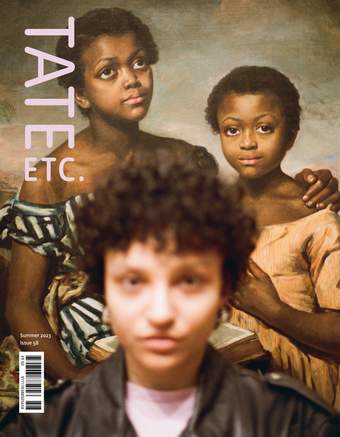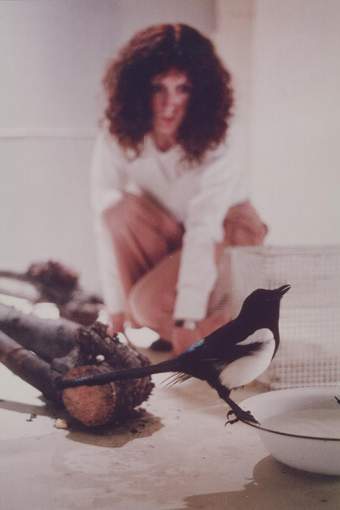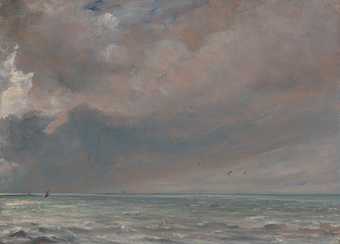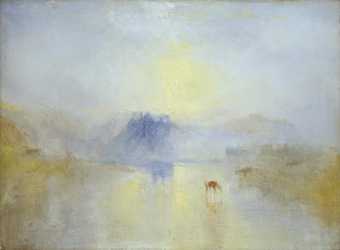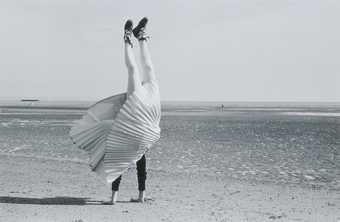
Rose Finn-Kelcey
The Restless Image: a discrepancy between the seen position and the felt position (1975)
Tate
The sea withdrew. Perhaps in pity. Or to regather itself and rise again. Or else in quiet contemplation, to manage and contend with the numerous springs, pools, lakes and rivers that run downstream from all corners to pour into it, eager, as Ovid puts it, to ‘enter the broad expanse’. The poet here makes an unusual suggestion, that such tributaries search for the sea partly out of a secret motive to be released from the confines of their boders, to exist outside of the familiar and be, once and for all, absorbed by a greater mass of open water, lapping against ‘the shore instead of their banks’. And isn’t that what we do when, in certain moods, we wander down to the beach?
The sea changes human time because the sea follows celestial time. It is, in other words, caught up in its own habit. And when we walk to it, we sense this; we sense, as the poet Mary Oliver writes, that the sea has its own ‘work to do’. The deeper we venture into our delusion that we are nature’s central protagonist, that our crisis is the environmental crisis, the more the sea becomes a complicated bedfellow, the neighbour who, we suspect, has its own schemes, some of which might be intent on upending ours.
At the very beginning of time – the way Ovid imagines it – the sea and all the elements of nature were in constant flux, a state of pure chaos. But chaos here is presented not simply as confusion, but a kingdom of indifference. And doesn’t the world seem chaotic when, say, someone we love does not pay us any mind? Or when we are stranded at sea, risking life and child for safe harbour, and those on dry land, indifferent to our fate, turn us back? In Ovid’s beginning, such a world was naked of distinction; it was not clear where one thing ended and another began. Then ‘god who is nature was kinder and brought this dispute to a settlement. / He severed the earth from the sky and he parted the sea from the land…'
Rose Finn-Kelcey’s The Restless Image: a discrepancy between the seen position and the felt position is a photograph in which the artist stands upended at the location
of that severance, at the meeting point between land, water and the heavens. An upside-down, alabaster-legged swan whose eyes, we imagine, are just at this moment purple with blood. She appears as though rejoicing in that post-chaos settlement of the world where nature can finally be hospitable to our imagination.
But then the picture changes again. The legs are not the first thing to be disbelieved. Which is why the sullied hem of that fanning skirt, with its evidence of life, is reassuring. It and the hands pressed on the sand are the only markings, the only signs that we are on earth. The pulled-up sleeves too, and the wrists beneath them, which appear worryingly strained. A woman upturned, head over heels, in flight, and yet so held in place, caught, like a shell listening. The world beyond cannot be more indifferent. It cannot be less playful or witty. Less vacuous or wanting. A receding terrain, vanishing into the withdrawing distance.
Far towards the horizon – at the place where we have deposited our despair, our hopes and worries for the future, our questions about what happens next, how we will fix the mess we have created, how best to get a good night’s sleep given everything we know, what food to eat given everything we know, and what would be the kindest, bravest, most loving and most necessary thing we ought to tell the children – out there on that furthest exposed patch of seabed, stands a figure. He is dressed in black, poised in such a way that it is not clear whether he is coming or going. Like the rider that Titian places in the background of The Death of Actaeon 1559–75, he too is seeing what we are looking at. He is our reflection, our mirror-self looking from the opposite direction, from a perspective that implicates us. A reminder that to look at anything is to cast our shadow onto it. In this sense, the artist places us in silent collusion with him.
At the other end of the frame, and further away, sitting right on the horizon, with the far distant hills pressing through the mist behind it, is an iron country, what appears to be a tanker marooned by the outward tide. A journey interrupted, and either coming from it or heading toward it is a small boat of some kind – or is it a rock?
Like a mirage, the whole scene is unreliable and appears at once trembling and fixed in place. Framed by this immobility, this colourless desolation, is the vigorous woman in motion, our protagonist, the heroine who, at this moment, represents all of us. Just as a fish’s hunger for life is never more ardent than when caught in a net, she is at once tremendously alive and expiring. And isn’t this also how we feel when, in certain moods, we see our predicament: that we are so very alive and yet inescapably caught in the web of time? Cover the lower half of the picture and it is as though we are looking down from a great height at a barren landscape, catching, for a flashing instant, the capsized shape of a woman falling. The shoes, once a ballerina’s but now made for walking, become the most elaborate object. Whereas the skirt sings, the shoes speak. Their tangled laces are involved in a two-way conversation. They are sociable shoes, well-acquainted with crowded places, have tinkered with the legs of chairs and nudged doors open.
Cover the upper half of the photograph and the shadow of the woman looks like that of a deer thinking about next steps. This is a picture of disappearing borders. The seashore is, after all, one of the few real borders; most others are invented. But here such a claim is unconvincing, because the woman, the man in the distance and the tanker cannot be more divided from one another. While the sea is far away and timid.
Now cover your eyes, and after a brief silence you too might see the woman emerge, full of playful wonder, not falling at all but turning, on and on, and the heart rises with her, like that hopeful moment when Mopsus the seer ‘noticed a rust-winged bird emerging out of the pile and soaring into the air’, a restless image, where the discrepancy between the seen position and the felt position can be sustained and lived.

